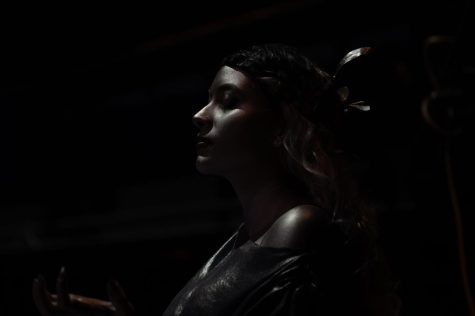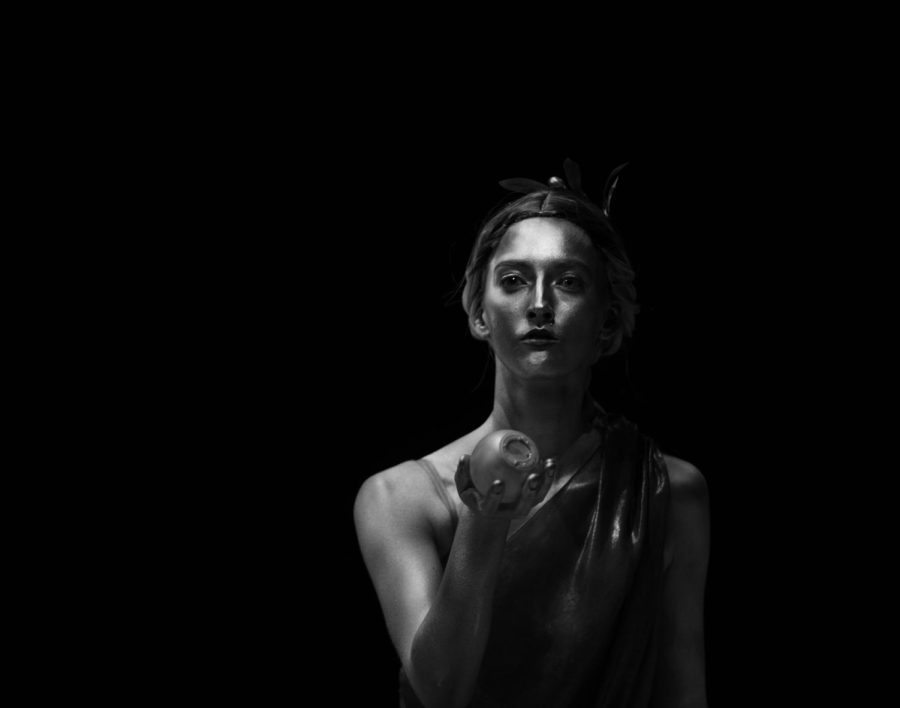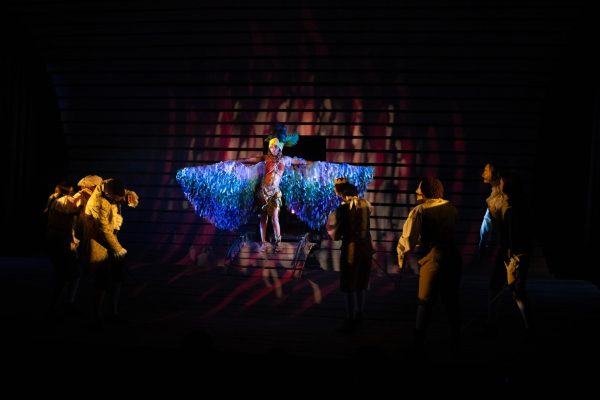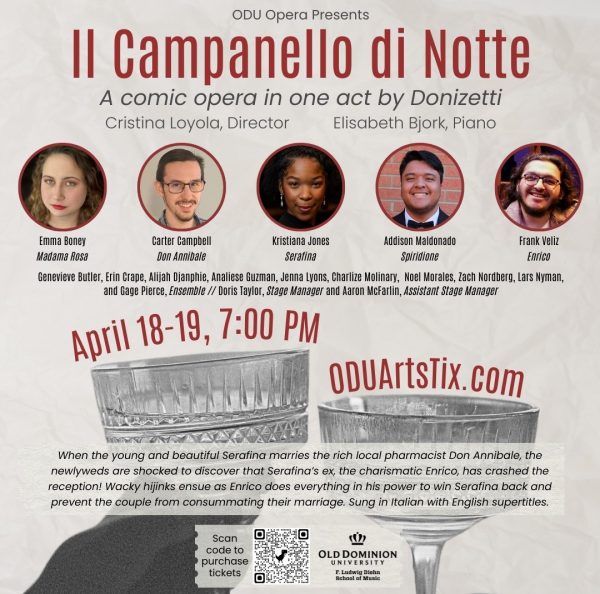Greek Mythology Retelling “Artemis, I” Opens at Goode Theatre
HG Bjork is Athena in “Artemis, I.” “Artemis, I” is a contemporary Greek tragedy produced by ODURep.
The much-anticipated production of “Artemis, I” opened on Feb. 23, 2023 to a nearly full house. The audience was brought into a space transformed into the garden of the goddesses, with the leaves of the backdrop washed in green light and silver-painted actors posing as statues on the stage and among the audience. Background noises of chirps and chatters completed the illusion of a rustic but grand temple. The lights went down and everything went quiet before a scream of rage and grief marked the show’s beginning.
Artemis, played by Anna Sosa, launched into a venomous monologue that held nothing back in displaying the goddess’s grief, rage, and power.
“I love the opening monologue, it’s not a pretty monologue by any means,” said Sosa.“If you are someone who has a lot of challenges with your surroundings and all of the hard things that are happening in this world currently, you probably are going to love hearing it.”
“Artemis, I,” written and directed by Deborah Wallace, is a retelling of the story of Iphigenia that highlights the titular goddess’s point of view when King Agamemnon kills her sacred deer. Artemis swears revenge and halts the winds to prevent the Greek armies from sailing to war until her demand of an equal sacrifice in the form of Agamemnon’s daughter, Iphigenia, is met.
Wallace pays homage to classic Greek plays by including a Greek chorus and an oracle. The Pythia is a priestess of Apollo who receives visions of the future. In “Artemis, I,”she delivers a prophecy of disaster to Agamemnon. The character is not in the original telling of the story, but was included by Wallace because she loved her involvement in other Greek stories.

“While it is a smaller role, I feel like she has an awesome impact on the story,” said Reicse Owen, ODU junior, who plays The Pythia.
There is a surprise collaboration between the costume and lighting designers for the scene where the Pythia delivers a prophecy from Apollo, showing a frighteningly divine connection between the two.
The play includes a Greek chorus, but instead of casting nameless extras, Wallace wrote in a pantheon of ten Greek war goddesses, including Athena, Nike, Ioke, and others. They are the actors who are posed around the stage when the audience first comes in. The chorus is brought to life by Artemis to help her orchestrate her revenge. Music and choreography play an important role in the goddess’s parts; the opening scene includes a choreographed dance number and the musical interlude in the middle of the play has the goddesses inform the audience of the background of the Trojan War.
“The dance at the beginning symbolizes that [the goddesses] are in sync, that they’re willing to fight with [Artemis],” said Adrian Rivera, who played Achilles.
The cast was full of talented actors, with the main role of Artemis played by Anna Sosa, supported by Angelina Paquin as Iphigenia, Brian Jinright as Agamemnon, and Leila Bryant as Clytemnestra.

The pantheon of war goddesses, including Samantha Kay Hendrix who created the choreography, displayed excellent acting and choreography work.
The show has been modernized in its language and its costume. Though the goddesses evoke classical Greek fashions, the mortals have been designed with contemporary fashions. The costumes are simple and primarily made of linen, and they would not be out of place in a modern Mediterranean city.
“We all look like we’re going to a destination wedding,” said Paquin.
“The look is pretty modern,” said Wallace. “It certainly has references to the ancient world, but the design is modern, the music that we use is very modern.”
This play uses ancient characters and stories to explore universal themes through a modern lens. The performance is accessible to people who may not know anything about the source material. This grand spectacle will shake audiences to their very core by getting their blood pumping, tugging on their heartstrings, and chilling them to their bones.
“Artemis, I” will continue to play through Mar. 5 at Goode Theatre. Tickets can be purchased for $5 for ODU students and $15 for the general public. They are available to buy in person at the box office and online here.

Ash F.J. Thomas is an English major working as the Arts & Entertainment Editor. Ash likes to review the many artistic events and exhibitions at ODU...

Elena Harris is a speech pathology major and photography minor graduating in the spring of 2023. Outside of the Mace and Crown, Elena enjoys the ODU experience...








